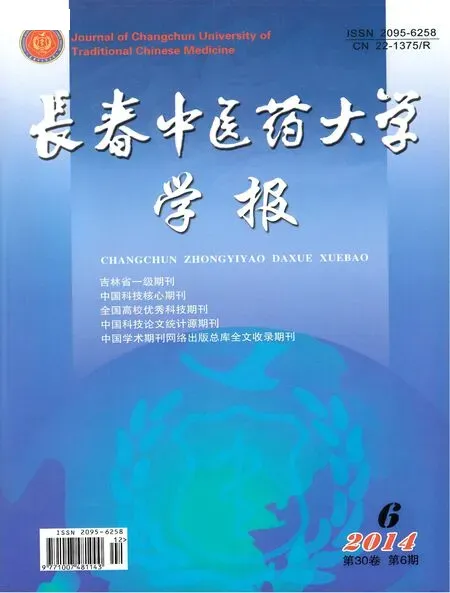卵巢早衰易感基因研究
曹晓静,王小云
(广州中医药大学第二临床医学院,广州510120)
卵巢早衰(premature ovarian failure,POF)是由于卵巢合成性激素功能低下,或者不能合成,降低了对下丘脑—垂体轴的负反馈作用,使得促性腺激素升高,雌激素水平降低的一种状态[1]。1950年首先由Atria描述,1967年由学者定义为:青春后期至40岁之间非生理性的闭经,伴有高促性腺激素和低促性腺激素的特征。病理基础为卵巢组织内卵泡几乎消耗殆尽,可表现为原发性或继发性闭经[2]。卵巢早衰的发生是多因素综合作用的结果,其中遗传因素之间的相互作用又错综复杂,更以个体的基因易感性为基础,现已发现了数十种基因通过不同的作用机制和致病途径影响卵巢功能,故对本病易感基因的研究也日益重要。
1 X染色体基因异常
1.1 FMR1(fragile X mental retardation 1 gene)Barasoain等[3]进行的一项随机对照研究发现,POF组中FMR1等位基因的中间体和前突变(35-54CGG重复序列)数目显著增加,表明了其对POF的发生有致病作用。Gleicher等[4]研究也发现,FMR1基因上超过30个三重CGG的重复序列,会显著增加POF的发生。也有研究则一步发现,CGG重复数目超过200时,就会引起POF;从而探讨了FMR1基因上的CGG重复序列可成为一种预测卵巢功能的新方法。也有学者发现POF家族性遗传患者常携带FMR1基因前突变,这也意味着,FMR1基因是导致本病的易感基因,亦是目前唯一被证明的基因。
1.2 BMP15(bone morphogenetic protein 15)BMP15是卵母细胞衍生生长因子,是哺乳动物卵泡分化过程中的主要因素,其早已被证明与POF的发生有关。通过对POF患者的BMP-15基因编码区进行序列分析,进一步探讨了其9种突变,包括6个错义替换,3个核苷酸嵌入;Rossetti等[5]发现意大利女性群体中 BMP-15基因突变率为2%(6/300),且443T>C突变的致病力最强。另有研究[6]认为,BMP15作为卵母细胞中的表达基因,能促进颗粒细胞增殖,其变异可导致POF。
2 常染色体基因异常
2.1 FOXL2(forkhead transcriptional factor 2 gene)FOXL2基因位于3q23,其突变可导致一种罕见的常染色体显性遗传病——BPES综合征(睑裂狭小、上睑下垂、倒转型内眦赘皮综合征),临床上分Ⅰ型和Ⅱ型,Ⅰ型除了眼睑异常外,女性患者还发生卵巢早衰;且有研究发现BPES患者的FOXL2基因出现了新的突变:胸苷删除——c.627delT(g.864delT),这也表明了FOXL2的变异对POF的影响[7]。Schlessinger等[8]发现FOXL2的缺失会导致单倍体缺失,从而引起卵巢细胞数量的减少。
2.2 GDF9(Growth differentiating factor-9 gene)GDF-9是1993年Mepherron等根据已知transforming Growth Factor-p(TGF-p)家族成员的保守序列,通过核苷酸变性技术发现的另一个TGF-p家族新成员,也是第1个被公认的卵母细胞源性生长因子,位于5号常染色体上,由2个外显子和1个内含子组成。其变异可促进颗粒细胞增殖,从而导致POF的发生。既往研究显示,GDF9基因的变异也是导致POF的致病因子,并通过进一步的随机对照研究发现,印度女性和白种女性POF患者中GDF9基因外显子1均存在明显突变。
2.3 甲状腺球蛋白基因(thyroglobulin gene)甲状腺球蛋白基因位于人类染色体8q24.2-q24,长300 kb,共有48个外显子。Jung等[9]发现韩国POF患者该基因的三个单核苷酸多态性——等显性的(AA、AB、BB)、显性的(AA、AB、BB)和隐性的(AA、AB、BB)存在变异;也通过病例对照关联研究揭示了HSD17B4基因单倍型与POF抵抗显著相关。此外,位于HSD17B4和甲状腺球蛋白的两个错义的SNPs(rs28943592,rs2076740)与POF易感性明显相关[10]。
2.4 ESR1 基因(estrogen receptor α gene,ESR1)Emerson等[11]检测了 ESR1(PvuII/XbaI)基因的多态性,并通过多因素回归分析和单倍体分析,认为巴西POF患者中ESR1基因的遗传变异(PvuII位多态性)值得关注;而Qin等[12]则发现ESR1基因中的rs2234693与POF有关,并较其他基因更值得关注。Liu[13]则通过对155例中国POF患者的研究发现,患病组ESR1基因的PvuⅡ位多态性的频率为38.1%,显著高于对照组的28.0%,且XbaⅠ位多态性的频率则为21.0%,高于对照组的8%,从而表明ESR1基因的PvuⅡ位和XbaⅠ位多态性是POF的潜在遗传危险因素;另有对朝鲜族POF患者的研究显示,ESR1基因PvuⅡ位和XbaⅠ位多态性可增加POF发病风险,并进一步研究了其风险的继承模式及作用机制[14]。
2.5 INHα 基因(inhibin α gene)Golla等[15]通过分析揭示了印度POF患者INHα基因中769G→A的变异性改变,主要3个基因序列的变异与POF发病密切相关,从而明确了遗传标记;Kathryn[16]进行了INHα基因启动子多态性的基因分型研究,发现所有POF患者的124G等位基因均减少,且INHA启动子单倍型C和D在POF患者中也锐减,由此得出结论,INHα基因启动子变异与POF的发展有关;另有研究者[17]通过文献检索对INHα基因的突变频率进行Meta分析后认为,INHα基因G769A变异导致抑制素B生物活性的降低,且这种变化可能是导致POF的易感因素。
3 其他基因
Diego等[18]发现,CDKN1B 基因(cycling-dependent kinase inhibitor1B gene)新表型的突变(c.356T>C,p.Ile119Thr)与 POF 潜在相关;Young等[19]通过前瞻性研究发现,VEGF(vascular endothelial growth factor)基因多态性与韩国女性POF发生率升高密切相关;Pyun等[20]发现位于染色体1q31的LAMC1(Antibody to Laminin Gamma 1)基因属于疾病密切相关区域,其中9个SNPs的分布和1个单倍体(HT1,C-CT-G-C-C-A-T-T-C)在POF患者中明显升高,从而揭示LAMC1与POF风险的增加显著相关;Wang等[21]发现FOXO3(Forkhead box O3)基因编码区的6类新单核苷酸的变异可能会导致异常的卵母细胞凋亡和窦状卵泡激活,导致卵巢中卵泡过早耗竭;也有学者[22]发现POU5F1(POU class 5 homeobox 1)基因的一个非同义变异(c.C37A,p.Pro13Thr)在 POF患者身上得到确认,从而表明其与POF有潜在关联;DORA等[23]在POF患者身上发现了CITED2(CBP/p300interacting transactivators with ED-rich termini2)基因的非同义突变,从而表明其变异与POF发生潜在相关。
4 结语
笔者查阅近几年文献发现了与POF发病密切相关的候选基因,但仍存在诸多问题,如研究侧重面较窄、样本量较少等问题,需要更多的研究来证明上述基因在POF进展过程中的作用机制及致病过程。
[1]曹泽毅.中华妇产科学(临床版)[M].北京:人民卫生出版社,2010:496-499.
[2]曹泽毅.中华妇产科学[M].2版.北京:人民卫生出版社,2004:2565-2568.
[3]Barasoain M,Barrenetxea G,Huerta I,et al.Study of FMR1 gene association with ovarian dysfunction in a sample from the Basque Country[J].Gene,2013,521(1):145-149.
[4]Gleicher N,Weghofer A,Barad D H.A pilot study of premature ovarian senescence:I.Correlation of triple CGG repeats on the FMR1 gene to ovarian reserve parameters FSH and anti-Müllerian hormone[J].Fertil Steril,2009,91(5):1700-1706.
[5]Tiotiu D,Alvaro Mercadal B,Imbert R,et al.Variants of the BMP15 gene in a cohort of patients with premature ovarian failure[J].Hum Reprod,2010,25(6):1581-1587.
[6]Rossetti R,Di Pasquale E,Marozzi A,et al.BMP15 mutations associated with primary ovarian insufficiency cause a defective production of bioactive protein[J].Hum Mutat,2009,30(5):804-810.
[7]Corrêa F J,Tavares A B,Pereira R W,et al.A new FOXL2 gene mutation in a Woman with premature ovarian failure and sporadic blepharophimosis-ptosis-epicanthus inversus syndrome[J].Fertil Steril,2010,93(3):1006.e3-1006.e6.
[8]Laissue P,Lakhal B,Benayoun BA,et al.Functional evidence implicating FOXL2 in non-syndromic premature ovarian failure and in the regulation of the transcription factor OSR2[J].J Med Genet,2009,46(7):455-457.
[9]Pyun J A,Kang H,Kim J,et al.Thyroglobulin gene is associated with premature ovarian failure[J].Fertil Steril,2011,95(1):397-400.
[10]Pyun J A,Kim S,Cha D H,et al.Epistasis between the HSD17B4 and TG polymorphisms is associated with premature ovarian failure[J].Fertil Steril,2012,97(4):968-973.
[11]Cordts E B,Santos A A,Peluso C,et al.Risk of premature ovarian failure is associated to the PvuII polymorphism at estrogen receptor gene ESR1[J].J Assist Reprod Genet,2012,29(12):1421-1425.
[12]Qin Y,Sun M,You L,et al.ESR1,HK3 and BRSK1 gene variants are associated with both age at natural menopause and premature ovarian failure[J].Orphanet journal of rare diseases,2012,7(5):1-6.
[13]Liu L,Tan R,Cui Y,et al.Estrogen receptor α gene(ESR1)polymorphisms associated with idiopathic premature ovarian failure in Chinese women[J].Gynecol Endocrinol,2013,29(2):182-185.
[14]Yang J J,Cho L Y,Lim Y J,et al.Estrogen receptor-1 genetic polymorphisms for the risk of premature ovarian failure and early menopause[J].J Womens Health(Larchmt),2010,19(2):297-304.
[15]Prakash G J,Ravi Kanth V V,Shelling A N,et al.Mutational analysis of inhibin alpha gene revealed three novel variations in Indian women with premature ovarian failure[J].Fertil Steril,2010,94(1):90-98.
[16]Woad K J,Pearson S M,Harris S E,et al.Investigating the association between inhibin alpha gene promoter polymorphisms and premature ovarian failure[J].Fertil Steril,2009,91(1):62-66.
[17]Chand A L,Harrison C A,Shelling A N.Inhibin and premature ovarian failure[J].Hum Reprod Update,2009,16(1):39-50.
[18]Ojeda D,Lakhal B,Fonseca D J,et al.Sequence analysis of the CDKN1B gene in patients with premature ovarian failure reveals a novel mutation potentially related to the phenotype[J].Fertil Steril,2011,95(8):2658-60.e1.
[19]Jeon Y J,Choi Y,Shim S H,et al.Vascular endothelial growth factor gene polymorphisms in Korean patients with premature ovarian failure[J].Eur J Obstet Gynecol Reprod Biol,2011,159(1):138-142.
[20]Pyun J A,Cha D H,Kwack K.LAMC1 gene is associated with premature ovarian failure[J].Maturitas,2012,71(4):402-406.
[21]Wang B,Mu Y,Ni F,et al.Analysis of FOXO3 mutation in 114 Chinese women with premature ovarian failure[J].Reprod Biomed Online,2010,20(4):499-503.
[22]Wang J,Wang B,Song J,et al.New candidate gene POU5F1 associated with premature ovarian failure in Chinese patients[J].Reprod Biomed Online,2011,22(3):312-316.
[23]Fonseca D J,Ojeda D,Lakhal B,et al.CITED2 mutations potentially cause idiopathic premature ovarian failure[J].Transl Res,2012,160(5):384-388.

